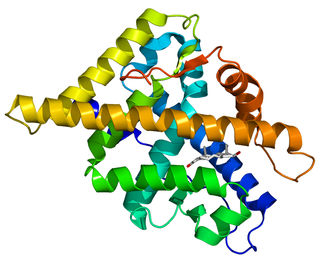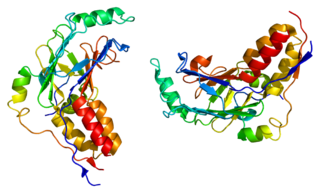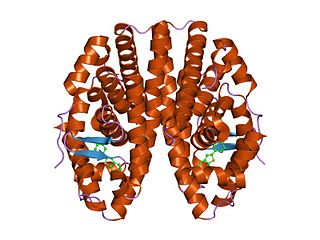SNW domain-containing protein 1 is a protein that in humans is encoded by the SNW1 gene. [5] [6] [7]
SNW domain-containing protein 1 is a protein that in humans is encoded by the SNW1 gene. [5] [6] [7]
This gene, a member of the SNW gene family, encodes a coactivator that enhances transcription from some Pol II promoters. This coactivator can bind to the ligand-binding domain of the vitamin D receptor and to retinoid receptors to enhance vitamin D-, retinoic acid-, estrogen-, and glucocorticoid-mediated gene expression. It can also function as a splicing factor by interacting with poly(A)-binding protein 2 to directly control the expression of muscle-specific genes at the transcriptional level. Finally, the protein may be involved in oncogenesis since it interacts with a region of SKI oncoproteins that is required for transforming activity. [7]
SNW1 has been shown to interact with:

The androgen receptor (AR), also known as NR3C4, is a type of nuclear receptor that is activated by binding any of the androgenic hormones, including testosterone and dihydrotestosterone in the cytoplasm and then translocating into the nucleus. The androgen receptor is most closely related to the progesterone receptor, and progestins in higher dosages can block the androgen receptor.

Histone acetyltransferase p300 also known as p300 HAT or E1A-associated protein p300 also known as EP300 or p300 is an enzyme that, in humans, is encoded by the EP300 gene. It functions as histone acetyltransferase that regulates transcription of genes via chromatin remodeling by allowing histone proteins to wrap DNA less tightly. This enzyme plays an essential role in regulating cell growth and division, prompting cells to mature and assume specialized functions (differentiate), and preventing the growth of cancerous tumors. The p300 protein appears to be critical for normal development before and after birth.

Mothers against decapentaplegic homolog 2 also known as SMAD family member 2 or SMAD2 is a protein that in humans is encoded by the SMAD2 gene. MAD homolog 2 belongs to the SMAD, a family of proteins similar to the gene products of the Drosophila gene 'mothers against decapentaplegic' (Mad) and the C. elegans gene Sma. SMAD proteins are signal transducers and transcriptional modulators that mediate multiple signaling pathways.

The vitamin D receptor (VDR) is a member of the nuclear receptor family of transcription factors. Calcitriol binds to VDR, which then forms a heterodimer with the retinoid-X receptor. The VDR heterodimer then enters the nucleus and binds to VDR responsive elements in genomic DNA. VDR binding results in expression or transrepression of specific gene products.

The ARNT gene encodes the aryl hydrocarbon receptor nuclear translocator protein that forms a complex with ligand-bound aryl hydrocarbon receptor (AhR), and is required for receptor function. The encoded protein has also been identified as the beta subunit of a heterodimeric transcription factor, hypoxia-inducible factor 1 (HIF1). A t(1;12)(q21;p13) translocation, which results in a TEL-ARNT fusion protein, is associated with acute myeloblastic leukemia. Three alternatively spliced variants encoding different isoforms have been described for this gene.

CREB-binding protein, also known as CREBBP or CBP, is a protein that in humans is encoded by the CREBBP gene. The CREB protein carries out its function by activating transcription, where interaction with transcription factors is managed by one or more CREB domains: the nuclear receptor interaction domain (RID), the KIX domain, the cysteine/histidine regions and the interferon response binding domain (IBiD). The CREB protein domains, KIX, TAZ1 and TAZ2, each bind tightly to a sequence spanning both transactivation domains 9aaTADs of transcription factor p53.

The SKI protein is a nuclear proto-oncogene that is associated with tumors at high cellular concentrations. SKI has been shown to interfere with normal cellular functioning by both directly impeding expression of certain genes inside the nucleus of the cell as well as disrupting signaling proteins that activate genes.

The nuclear receptor coactivator 1 (NCOA1) is a transcriptional coregulatory protein that contains several nuclear receptor interacting domains and an intrinsic histone acetyltransferase activity. NCOA1 is recruited to DNA promotion sites by ligand-activated nuclear receptors. NCOA1, in turn, acylates histones, which makes downstream DNA more accessible to transcription. Hence, NCOA1 assists nuclear receptors in the upregulation of DNA expression.

The nuclear receptor coactivator 2 also known as NCoA-2 is a protein that in humans is encoded by the NCOA2 gene. NCoA-2 is also frequently called glucocorticoid receptor-interacting protein 1 (GRIP1), steroid receptor coactivator-2 (SRC-2), or transcriptional mediators/intermediary factor 2 (TIF2).

The nuclear receptor coactivator 3 also known as NCOA3 is a protein that, in humans, is encoded by the NCOA3 gene. NCOA3 is also frequently called 'amplified in breast 1' (AIB1), steroid receptor coactivator-3 (SRC-3), or thyroid hormone receptor activator molecule 1 (TRAM-1).

The nuclear receptor co-repressor 1 also known as thyroid-hormone- and retinoic-acid-receptor-associated co-repressor 1 (TRAC-1) is a protein that in humans is encoded by the NCOR1 gene.

The nuclear receptor co-repressor 2 (NCOR2) is a transcriptional coregulatory protein that contains several nuclear receptor-interacting domains. In addition, NCOR2 appears to recruit histone deacetylases to DNA promoter regions. Hence NCOR2 assists nuclear receptors in the down regulation of target gene expression. NCOR2 is also referred to as a silencing mediator for retinoid or thyroid-hormone receptors (SMRT) or T3 receptor-associating cofactor 1 (TRAC-1).

Notch homolog 1, translocation-associated (Drosophila), also known as NOTCH1, is a human gene encoding a single-pass transmembrane receptor.

Retinoid X receptor alpha (RXR-alpha), also known as NR2B1 is a nuclear receptor that in humans is encoded by the RXRA gene.

Nuclear transcription factor Y subunit beta is a protein that in humans is encoded by the NFYB gene.

COUP-TFII, also known as NR2F2 is a protein that in humans is encoded by the NR2F2 gene. The COUP acronym stands for chicken ovalbumin upstream promoter.

Recombination signal binding protein for immunoglobulin kappa J region is a protein that in humans is encoded by the RBPJ gene.

Nuclear receptor coactivator 6 is a protein that in humans is encoded by the NCOA6 gene.

Tripartite motif-containing 24 (TRIM24) also known as transcriptional intermediary factor 1α (TIF1α) is a protein that, in humans, is encoded by the TRIM24 gene.

Mastermind-like protein 1 is a protein that in humans is encoded by the MAML1 gene.